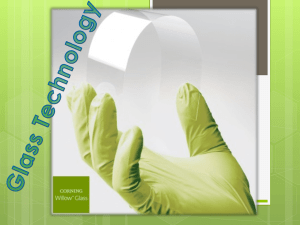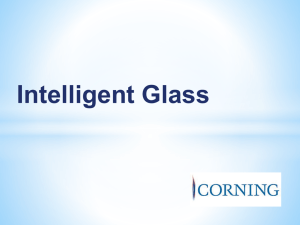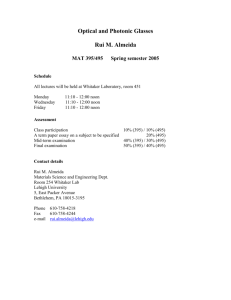Presentation - The University of Arizona College of Optical Sciences
advertisement
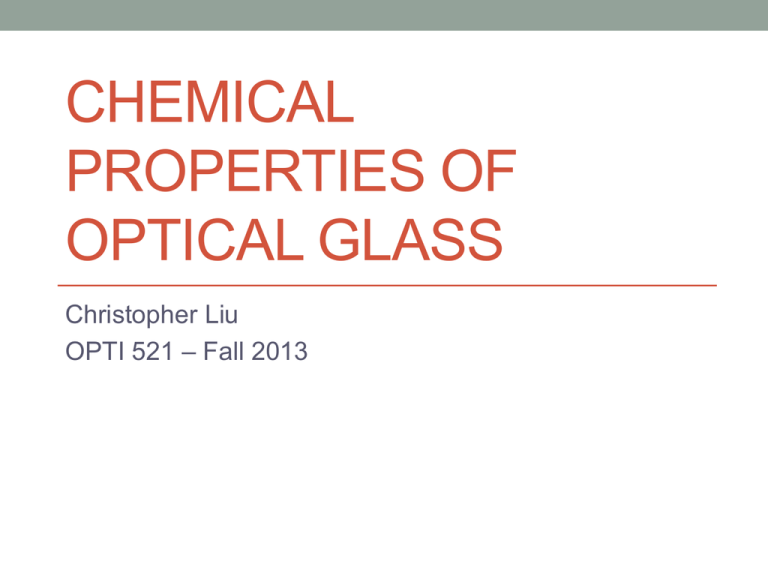
CHEMICAL PROPERTIES OF OPTICAL GLASS Christopher Liu OPTI 521 – Fall 2013 Why does chemical resistance matter? • Not every optical system is used in a controlled laboratory environment • Therefore, our design must accommodate the worst-case conditions the device will encounter Chemical structure of glass • Mostly SiO2 • Additives control physical, optical properties • Boric oxide – borosilicate glasses • Ba, La – high index • Hydroxyl radicals, Additives Hydroxyl Adapted from https://en.wikipedia.org/wiki/File:Silica.svg embedded water as impurities Overview of test procedures • Expose glass to accelerated-aging environment • Check for etching and visible surface changes • Climatic resistance (CR): water vapor • Stain resistance (FR): weak acids • Acid resistance (SR) • Alkali resistance (AR) and phosphate resistance (PR) Climatic resistance • Chemical: Water vapor • Temperature: 40-50°C (1 hour cycle period) • Duration: 30 hours • Worst glasses (CR 4): KZFS12, N-LAK21, N-SK14, N-SK16 Stain resistance • • • • • • Chemical solution I: Standard acetate, pH = 4.6 Chemical solution II: Acetate buffer, pH = 5.6 Temperature: 25°C Duration: Until 0.1 μm-thick stain (brown-blue) Worst glasses: SF57, SF66 (FR 5) Some glasses may be etched rapidly but appear to have a clean surface Acid resistance • Chemical solution I: Nitric acid, 0.5 mol/L, pH = 0.3 • Chemical solution II: Standard acetate, pH = 4.6 • Temperature: 25°C • Duration: Until 0.1 μm thickness etched • Worst glass: SF66 (SR 53.4) Alkali and phosphate resistance • Alkali solution: NaOH, 0.01 mol/L, pH = 12 • Phosphate solution: Na5P3O10, 0.01 mol/L, pH = 10 • Temperature: 50°C • Duration: Until 0.1 μm thickness etched • Cleaners are often alkaline, phosphatecontaining, applied at elevated temperatures Surface inspection • Visible surface changes are identified by an extra digit behind the acid/alkali/phosphate class • .0: No visible change – may be omitted • .1: Clear but uneven surface • .2: Interference colors • .3: Firmly adhered, thin white layer • .4: Loosely adhering, thick layers Overview of glasses SF66 The farther we get from BK region (higher n), the worse the chemical stability typically becomes N-SK16 F2 (good) Doublet lens considerations • For a converging achromatic doublet, why do we put the positive element in front? • Minimizes spherical aberration • Avoid exposing sensitive glass • Typical specs • N-BK7: CR 2, FR 0, SR 1, AR 2, PR 2.3 • N-SK16: CR 4, FR 4, SR 53.3, AR 3.3, PR 3.2 • N-F2: CR 1, FR 0, SR 1, AR 1, PR 1 (n=1.5168, v=64.17) (n=1.6204, v=60.32) (n=1.6201, v=36.43) • So the use of (N-)F2 as the negative element poses no major challenge. What if we need a thinner element? • KZFS12: • SF66: CR 4, FR 1, SR 53.3, AR 4.3, PR 4.3 CR 2, FR 5, SR 53.4, AR 2.3, PR 4.2 (n=1.6960, v=36.29) (n=1.9229, v=20.88) Doublet lens considerations • Specific situations • Dialyte (separated elements): Consider extra space • Multipart barrel or other disassembly: Risk of chemical attack on back element becomes important • Steam, chemical fumes: Check relevant ratings • Fully-cemented triplet: Middle element isolated from environment • Best practices for handling • Gloves, to avoid stains • Automated assembly machinery (if cost justified) • Adequate packaging for shipment, to seal out moisture • Climate-controlled storage (if cost justified) Conclusions • More additives = higher index and/or dispersion but more • • • • points of chemical attack First, try to avoid using sensitive glasses Otherwise design to avoid exposing sensitive glasses to environment Special handling if needed Test glass samples and/or device prototypes for aging if needed References • "Bk7 Optical Glass Flats from VPG." http://www.vpglass.com/optical_glass/bk7_glass.html. Volume Precision Glass, Inc. • "Optical Glass – Description of Properties." Schott, June 2003. Supplied by University of Arizona, OPTI 521 class notes, 2013. pp. 6-33. • "SCHOTT BOROFLOAT® 33 Borosilicate Glass." http://www.us.schott.com/borofloat/english/index.html. Schott North America, Inc., 2013. • "TIE-30: Chemical properties of optical glass." Technical Information – Optics for Devices. Schott, July 2004. Supplied by University of Arizona, OPTI 521 class notes, 2013. pp. 1-9.
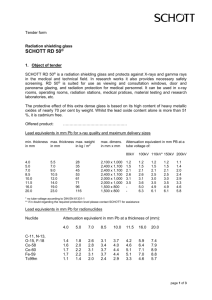
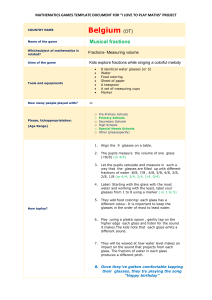
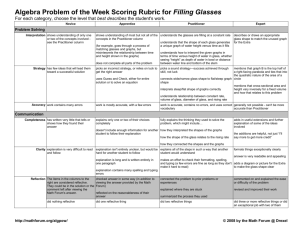
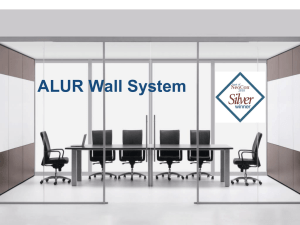
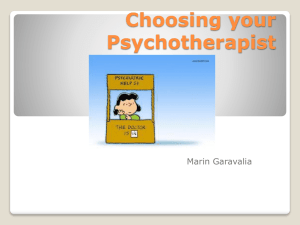
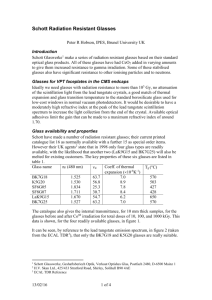
![[] Otto Schott Research Award 2007 goes to two internationally](http://s3.studylib.net/store/data/007250788_1-523464410b3833473f019c271e813377-300x300.png)


